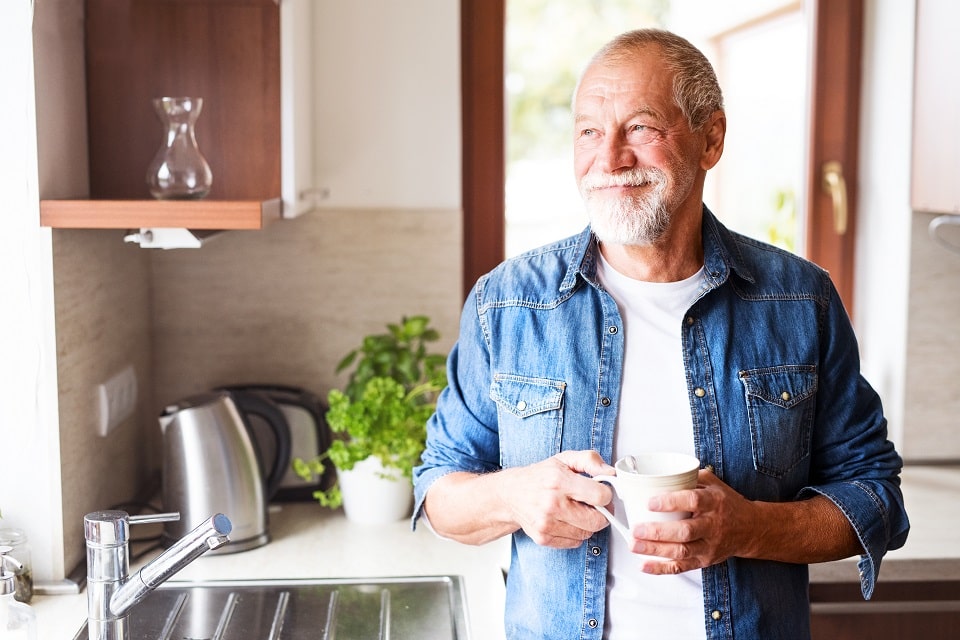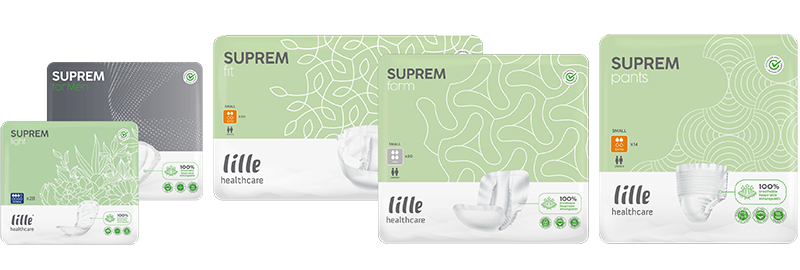Information & Advice
Living better with your incontinence on a daily basis

What is incontinence?
Incontinence is defined as an involuntary and uncontrollable leak of urine occurring both during the day and at night. The loss of urine varies from person to person and can go from a couple of drops due to effort to a complete and involuntary emptying of the bladder. So, we’re talking about urinary incontinence. Faecal incontinence also exists.
Incontinence is not an illness but, most of the time, a symptom linked to a physical problem. In the majority of cases, there are solutions to solve this issue or control it. That’s the reason it is important to talk about it with your doctor.
Types of Incontinence
There are different types of incontinence that manifest themselves in different ways depending on the person. Below is a list of the most common forms.
Stress Incontinence

Stress Incontinence
This is a weakness of the pelvic floor muscles and/or urinary sphincter, which means that the bladder’s “exit door” doesn’t close correctly. Urinary loss can occur in little gushes, when you laugh, cough or during physical effort. This incontinence is often linked to a lack of tone in the pelvic floor. It’s the most frequent form of incontinence and it affects women especially.
Urge Incontinence
Urge Incontinence
This type of incontinence translates to a very frequent urge to urinate that doesn’t leave enough time to get to the toilet. This form is linked to hyperactivity in the bladder muscles, which contract abnormally. Urine leakage occurs if the urge to urinate cannot be satisfied quickly enough. The leak can happen suddenly, just by touching water or hearing water flow, for example, or even when you anticipate going to the toilet (when arriving at home, the simple act of putting the keys in the door).

Overflow Incontinence (or Urine Retention)

Overflow Incontinence (or Urine Retention)
This incontinence is explained by a problem in the discharge function of the bladder, meaning an “overflow”. This mechanism leads to bladder leaks, drop by drop, because it’s just the overflow that is evacuated. This is the most common form in men. This can happen in particular when the size of the prostrate increases.
Functional Incontinence
Functional Incontinence
This type of incontinence translates to a person’s inability to get themselves to the toilet because of a cognitive or physical disability. It often occurs in elderly people who have difficulty moving or in people with Alzheimer’s.

Total Incontinence

Total Incontinence
The sufferer can no longer exercise any control over their bladder. Total incontinence is often the consequence of a physical injury, a spinal cord illness, a destruction of the sphincters, etc.
Nocturia and enuresis (Night time incontinence and bed-wetting)
Nocturia and enuresis (Night time incontinence and bed-wetting)
The term nocturia refers to the abnormally increased need to urinate during the night. This can affect adults suffering from kidney problems leading to renal failure or men suffering from a begin hypertrophy of the prostate. People suffering from enuresis urinate when they sleep, most often at night.

Let yourself be guided
Find the product suitable for every situation!

Advice and Practical Information
Healthy eating
Here is some simple advice to help you tackle your bladder problems on a daily basis and enjoy life to the fullest.

Keep hydrated
Make sure you drink plenty of water. If you don’t drink enough water, your urine will be more concentrated and could irritate your bladder. It is important to drink enough water while eating a balanced diet.
Curb your consumption of alcohol
Consuming alcohol affects the messages that your brain sends to your bladder to tell it when to hold on to urine and when to get rid of it. We would therefore advise reducing your alcohol consumption as much as possible.


Avoid fizzy drinks
The carbon dioxide in this type of drink can irritate a sensitive bladder and give you an urgent need to urinate.
Avoid caffeine
Stop or reduce your caffeine consumption because it can make you need to go to the toilet and prompt your body to rid itself of liquids. You should avoid fizzy drinks, tea, hot chocolate and even decaf coffee.


Avoid spicy food
Avoid eating spicy food like Mexican or Chinese dishes, pepper, chilli or horseradish if you have an overactive bladder because these foods can cause bladder irritation.
Avoid acidic food
Citrus fruit or tropical fruit juices, like orange and pineapple, contain acid and can irritate your bladder. They can make you need to go to the toilet more often. Tomatoes and cranberries are also acidic.

Pelvic floor re-education and training
Re-educating and training your pelvic floor is proven to be useful inpreventing urinary loss.There are many factors that can explain the weakening of the pelvic floor muscles at one time or another. This weakening of the pelvic floor in men or women greatly increases the risks of urinary incontinence.
There are simple exercises that are easy to do at home, allowing you to strengthen the pelvic floor muscles.

For men
In a comfortable position, sat or lying down, try to relax yourthigh, gluteal and stomach muscles. Concentrate andtighten the muscles around your anus and release. Repeat this several times.
For women
In a comfortable position, sat or lying down, try to relax your thigh, gluteal and stomach muscles. Concentrate and tighten the muscles around the urinary area (as if you were holding in urine), the muscles around the vagina and around the anus. Release. Repeat this several times.
For women, pelvic floor re-education sessions can be carried out directly by a midwife.

Some advice for after giving birth

Well-known but still taboo, let’s talk about post-partum urinary incontinence. The weight of the baby weighs down on the pelvic floor for 9 months, which leads to a weakening of the pelvic floor muscles. In addition, the birth doesn’t help and the pelvic floor gets a little “battered”. Each birth increases the risk of urinary incontinence.
It is therefore essential to take care of the pelvic floor as soon as possible and this can be begun during the pregnancy with some pelvic floor strengthening exercises. Pregnant women should avoid too much weight gain, which can add to the weight weighing down on the pelvic floor, but it is also very important not to carry heavy loads.
Just after the birth, it is essential to give yourself some well deserved time to rest for the tissues that need it to recover and heal. After that, pelvic floor re-education is proven to be the only solution to prevent post-birth urinary loss.
It is important to keep in mind that not all women are the same and some may be more sensitive than others.
Lille healthcare is committed
In addition to finding you suitable products, Lille Healthcare is committed to other causes